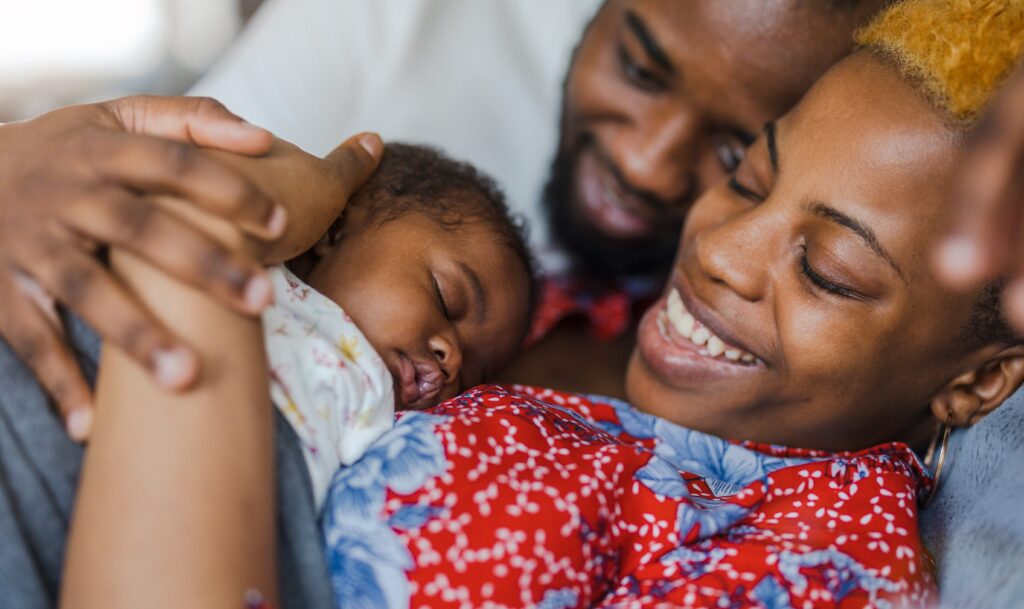By David Willis, MD, FAAP
The power of strong, positive, and nurturing relationships in a child’s early life to ensure their ability to manage stress and lead healthy lives as an adult is undeniable. In Nurture Connection’s February webinar, we spoke with Bruce D. Perry, MD, PhD, renowned researcher and coauthor of What Happened to You? Conversations on Trauma, Resilience, and Healing, with Oprah Winfrey. Dr. Perry expanded upon his research within the Neurosequential Model — a model that informs therapeutic work with children and families from a neurobiological perspective — and the unique importance that emotional connection beginning within the child’s first two months of life plays in building the very foundations for a stable central nervous system and regulatory network needed for life. So much so that a child is neurologically better equipped to manage daily life and confront life’s adversities.
According to Dr. Perry’s findings, “The single-most powerful predictor of outcomes in mental health domains that we looked at in later life was related to relational connection in the first two months of an individual’s life. That’s not to say that adversity wasn’t important, but relational health always outweighed the impact of adversity.” This connection early in life is a key protective factor that helps mitigate the impact of adversity and helps children to thrive.
With this groundbreaking research, Dr. Perry highlighted the importance of having social programming and policies to support a caregiver’s well-being, so that they, in turn, can foster a healthy connection with their child early in life.
How does the Neurosequential Model influence ERH in a clinical setting?
Grounded in the core principles of healthy brain development and the impact of trauma on long-term health and well-being, Dr. Perry’s Neurosequential Model is derived from over 35 years of research focused on integrating emerging principles of developmental neuroscience into clinical practice. Dr. Perry was most interested in understanding individuals’ developmental histories shaped by stressors they experienced in their formative years. His research helps explain the impact of adversity on the central nervous system (CNS) and the core regulatory networks, including serotonin, dopamine, and norepinephrine systems in the CNS.
A positive relational connection early on in life shapes these key CNS systems and lays the groundwork for helping a child manage stress, confront and adapt to adversity in healthy ways, and recover from difficult situations. By understanding an individual’s developmental history and current level of brain and behavior functioning, clinicians can better address a child’s or family’s situation and needs.
How can the Neurosequential Model inform social programming and policy?
This research also makes a strong case for Nurture Connection’s work promoting the importance of Early Relational Health (ERH) in Early Childhood Health (ECH) practices, research, and policymaking.
At ERH’s core, a caregiver must first have a sense of well-being, safety, and belonging before they can transfer those positive dynamics over to their child. Despite systemic issues like poverty, racism, and a lack of quality early child care, caregivers heroically provide and care for their children. However, the toll of these stressors can often result in parental burnout, which in turn can result in less consistent developmentally supportive environments for children and families. Efforts must, therefore, focus simultaneously on addressing the policy, systemic, and societal forces that disadvantage some families, especially Black and Brown families, while also investing in family supports that help families alleviate the stressors that impact their ability to care for their children.
Dr. Perry went on to explain that despite these challenges, there are still ways to create systems of support for families. Many caregivers and families, especially those who have experienced deep and persistent disadvantage and marginalization, can combat their burnout and feeling of being undervalued by mainstream society by building their own micro-community or bubble of belonging. As a lover of sports, Dr. Perry has been drawn to how sports, for example, can become an effective micro-community for parents and children alike. Programming that creates opportunities for children to regulate, connect, learn, and heal through sports can have a positive ripple effect for the children, families, and the broader community.
Dr. Perry also emphasized a bubble of belonging for older youth: “One community created Harlem Lacrosse. In Harlem they are providing kids the ability to learn this sport. You start by getting some resources to create this bubble of connectivity, and these kids do better in school, they do better in their physical health outcomes. That’s what we have to do. As an early childhood system, we all have to come together and look at where we can create these opportunities.”
While Dr. Perry acknowledges that the concept of micro-communities is already understood on an intuitive level by many caregivers and in many cultures, having the data to show the value of belonging and connection is critical for creating programs like Harlem Lacrosse.
Nationally we also need a concerted effort to put into place the kinds of policies that will create the conditions for families to thrive and nurture their children. Passing policies like parental leave, child tax credit, universal quality early child care, extension of Medicaid for mothers during the first year of a child’s life can all help alleviate the stressors that impact family health and well-being.
Dr. Perry’s research demonstrates that by prioritizing the relational needs of children and their caregivers on individual, local, and national levels, we as a society can ensure a better neurological and developmental basis for all children, which in turn further enriches society.
Bruce D. Perry, MD, PhD, is the principal of the Neurosequential Network and a professor (adjunct) in the departments of psychiatry and behavioral sciences at the Feinberg School of Medicine at Northwestern University in Chicago and the School of Allied Health, College of Science, Health and Engineering, La Trobe University in Melbourne, Australia.
